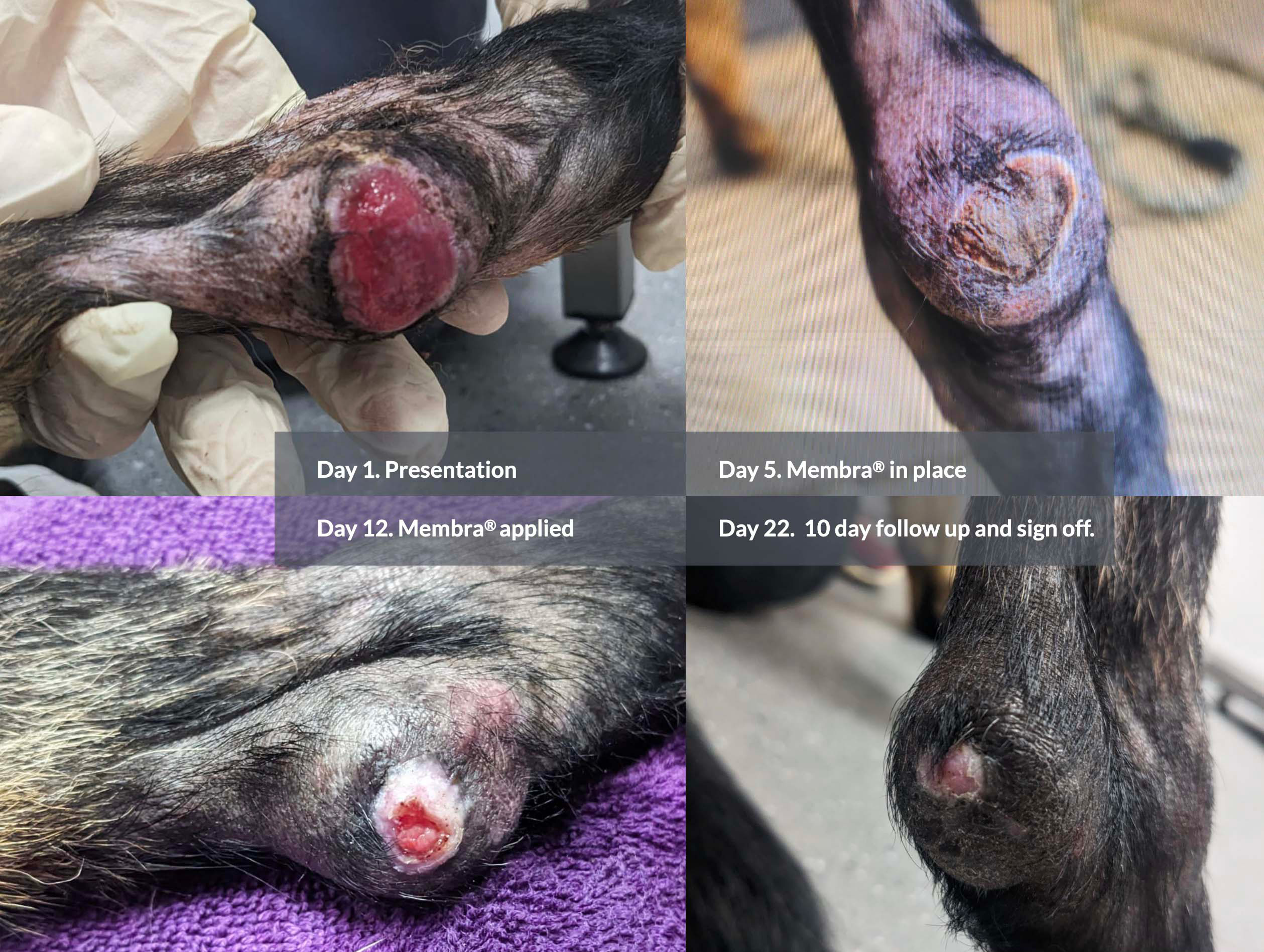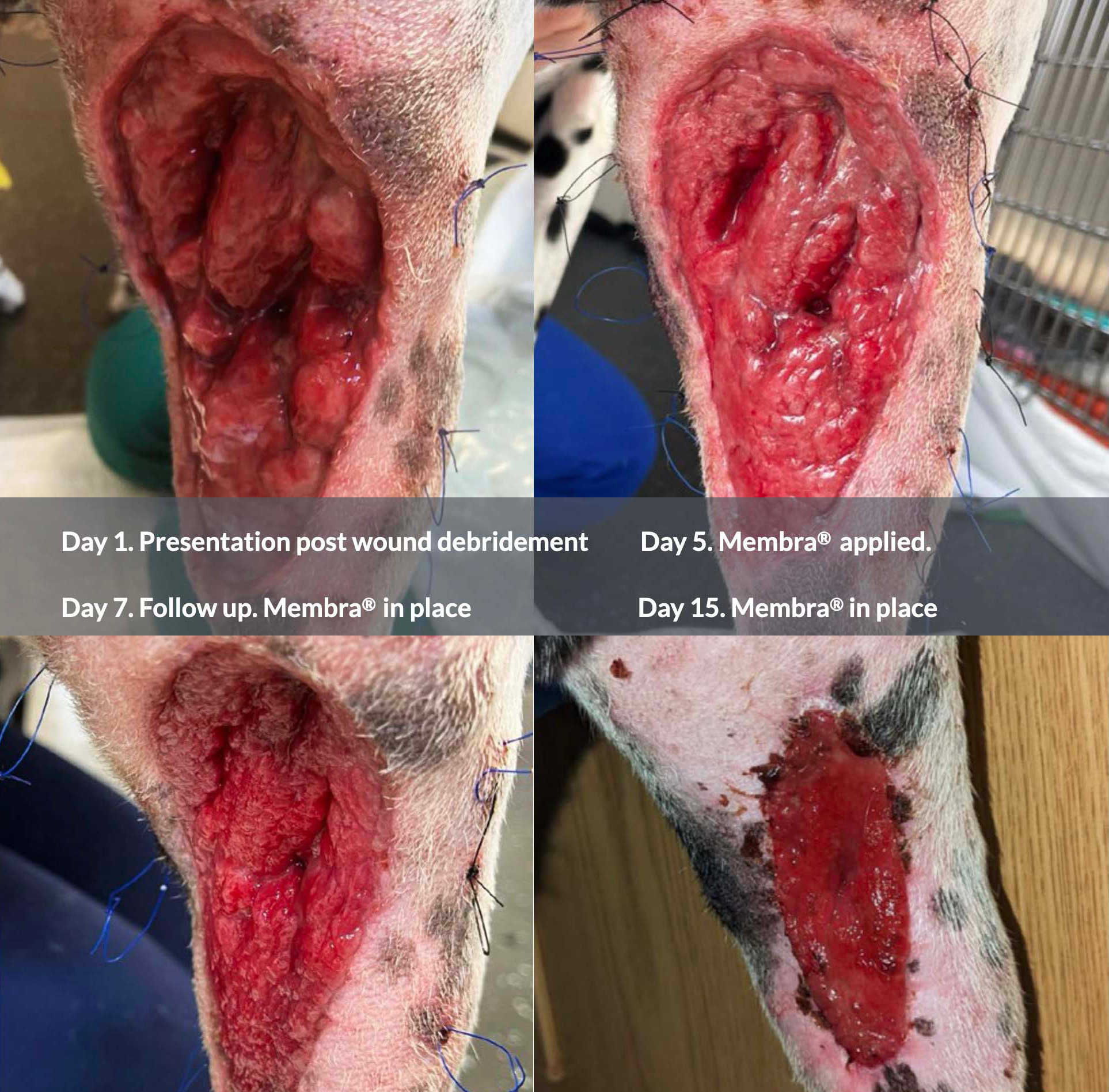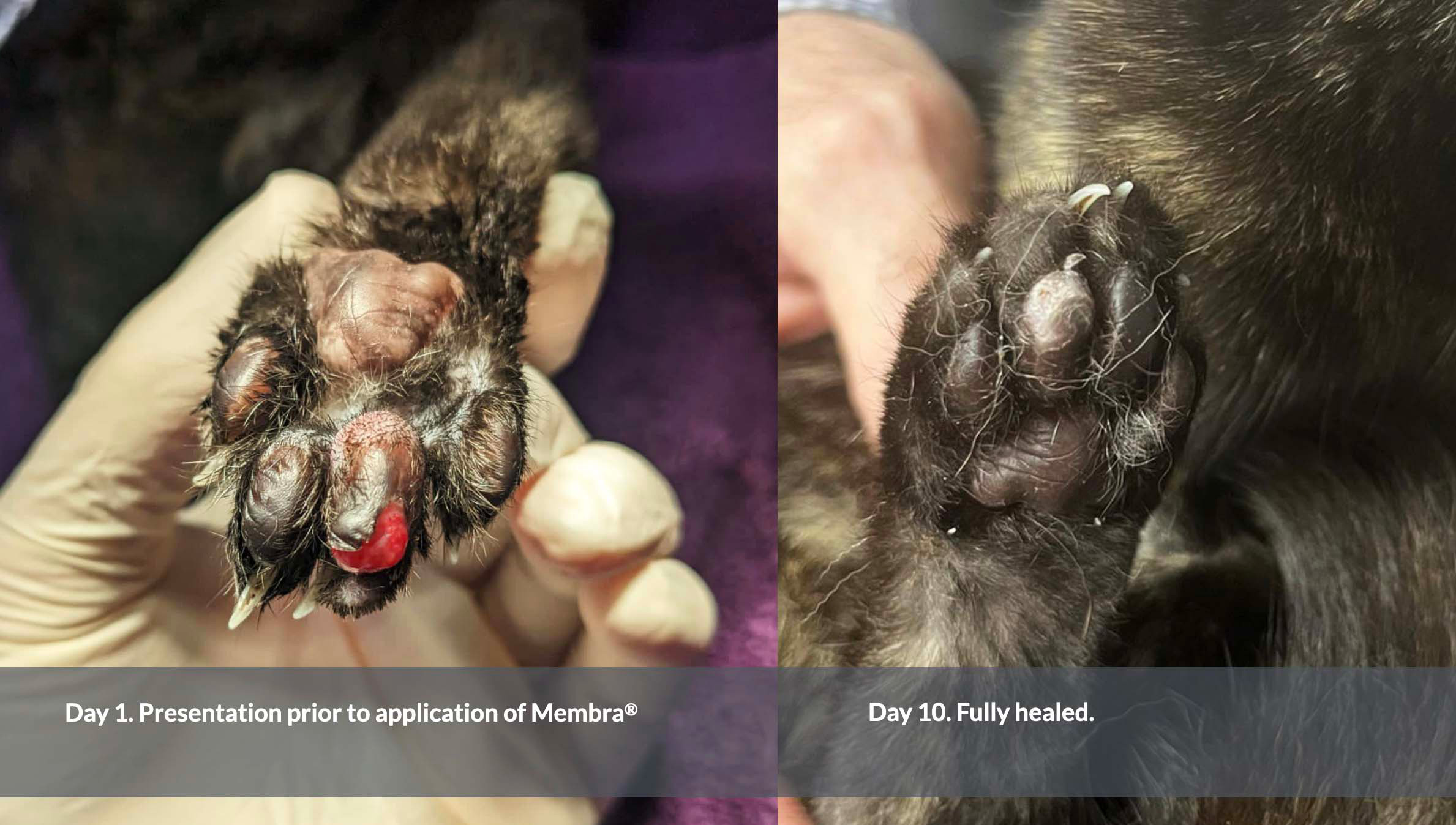10 Sept 2024
Georgie Hollis explains the numerous challenges dressings can cause and how to overcome them with moist wound healing without bandaging.

Where surgical repair is not an option for wound closure, a period of open wound management will be required.
Advanced wound dressings are designed to optimise healing through the creation of an optimal moist environment for efficient wound progression to occur. Common, everyday examples include polyurethane foams and hydrogels familiar to many in practice.
Advanced wound dressings sustain and hydrate the wound bed for extended periods to allow for longer intervals and support 30% to 50% faster healing compared to wounds allowed to dry and form an eschar1.
Wounds managed with dressings that provide a moist wound healing (MWH) environment have been shown to exhibit shorter periods of inflammation, are associated with improved collagen deposition, more efficient cell migration and reduced scarring as a result2.
Veterinary patients do not always make it easy to put MWH principles into practice. Applying and keeping dressings in place can be challenging. The majority of products are designed to adhere to relatively hairless human skin, and the patient size, wound location, temperament and husbandry bring a whole other set of challenges to keeping a dressing in place. For this reason most (if not all) wound dressings used on animals require either a secondary bandage or a tie-over dressing to keep them in place. This adds to costs and may also predispose to bandage-related injuries.
The approach to wound management varies according to the phase of healing, with exudate management and debridement during the inflammatory phase, and maintenance of moisture (MWH) most beneficial during the proliferative phase (Panel 1 and Figure 1).
The interval of dressing changes is highest during the inflammatory phase as exudate levels and slough peak in the first two to three days post-injury.
Daily dressing changes may be required to avoid excoriation and strike through.
As granulation tissue begins to form, intervals between dressing changes should be extended to allow for remodelling to occur without unnecessary trauma during dressing changes.
Many dressings intended for human use (such as foams, silicone dressings and hydrocolloids) will state on the packaging that they can be left in place for up to seven days to support the proliferative phase of healing. Unfortunately, this isn’t recommended in small animals where a secondary bandage is required to keep the dressing in place as the risk of complications will be significant during this time frame. A three to four-day interval of dressing change is the most commonly adopted in small animal practice.
Bandaging complications are not uncommon and where they occur they may become more problematic than the original wound (Figure 2).
Predisposition to complications can be assessed based upon known factors prior to management of wounds taking into account the patient breed, temperament and biomechanics. All should go well, as long as the client is on board with their role in maintaining a clean, dry bandage while keeping patient activity to a minimum (Panel 2).
A tie-over dressing is a cost-effective option to secure dressings in place (Figures 3a and 3b), but requires placement of multiple suture loops around the healthy wound margin.
They are usually limited in use to up to 14 days due to the inevitable foreign body reaction that will occur at each suture site. Margins may also be aggravated by tension and patient interference caused by some itching associated with the suture reaction.
The risk of bandaging complications, limitations of cost, safety and compliance issues are key reasons that a choice may be made to leave wounds totally uncovered (Figure 4).
A new technology has been developed that gives an option to continue with MWH without the need for a secondary dressing or bandage.
Membra (Animus Surgical) is a novel polyethylene glycol (PEG) hydrogel polymer that is applied directly to the open wound setting to form a transparent, moisture-retentive seal within 90 to 120 seconds.
It offers a bandage-free solution for all types of wounds that are in the proliferative phase that may benefit from extended intervals between follow-up and may be too risky or aversive to bandaging (Figure 5).
Over the past year, the wound sealant has been successfully used on small, exotic and equine patients illustrating some significant benefits when using a “bandage-free” moist wound healing solution.
Courtesy of Aisling Moore, MVB GP(Cert) PgC(SAD) MRCVS, advanced veterinary practitioner in small animal dermatology, Godiva Veterinary Clinic, Coventry
A lively working dog that experienced a traumatic injury to his left hind of unknown cause, resulting in multiple wounds that healed well, except for an area over the hock.
The dog was kept in a kennel, excitable and highly mobile. Prior bandaging had been challenging and pressure over the hock despite using an offloading technique was considered a high risk. Membra® was chosen as it provides a moist environment for optimal healing, 14-day wear time and avoids the need for subsequent bandaging.
Images from day zero of application to day 22 demonstrate good progress with two applications of the sealant.
Use of the wound sealant avoided the need for bandaging and continued visits at three to four-day intervals. Two applications of it were used at 10-day intervals with full resolution of healing within 22 days.

Figure 6. Case study 1 involved a lively working dog with a left hind injury. Image: Membra/Animus
Courtesy of Claire Tomkinson RVN NCert(E&CC) and team at Willow Veterinary Clinic, Stoke-on-Trent
A boisterous Dalmatian presented to practice for removal of a soft tissue sarcoma on the right caudal hindlimb. A mesh graft was used to fill the tissue deficit, but was unfortunately non-viable four days after the operation.
With the graft tissue non-viable, the wound was cleansed and debrided and dressed with manuka honey, and a foam dressing held in place with a tie-over dressing. The dog required sedation to achieve any wound care simply due to his boisterous nature. It was anticipated that dressing changes would become challenging as healing progressed through second intention.
The wound sealant was used to avoid the need for bandaging, and to reduce the number of visits and sedations required, while providing the optimal MWH environment for ongoing healing.
Wound progression was very positive, with the wound sealant staying in place for 10 days. During that time, the wound remained clean, granulation tissue appeared healthy and shiny and an absence of eschar formation was noted.
Wound contraction and healing progressed uneventfully, leaving just a small scar visible at a three-month check-up.

Figure 7. Case study 2, which dealt with a “boisterous Dalmatian”. Image: Membra/Animus
Courtesy of Aisling Moore, MVB GP(Cert) PgC(SAD) MRCVS, advanced veterinary practitioner in small animal dermatology, Godiva Veterinary Clinic, Coventry.
A young domestic short-haired cat presented with a traumatic wound to one of the pads on her right hind paw. The wound was healthy and granulating, but the area was fragile and sensitive.
The wound sealant was used as a primary wound dressing with a bandage applied over the top to ensure the area was protected on the first application. The second application did not have a bandage applied to cover it. The pad at 10 days post-application was fully healed.

Figure 8. Case study 3 involved a young domestic short-haired cat with a traumatic wound on one of its pads. Image: Membra/Animus
Moist wound healing is well established as the ideal environment for second intention healing, leading to faster, more efficient wound closure. Where bandaging is challenging or risky it can be a tough decision to leave a wound undressed, leaving it vulnerable to drying, increased trauma and healing delay.
With a long wear time and maintenance of a MWH environment, Membra is an example of a veterinary-specific solution that is easy to apply without compromising wound care.
It is ideal for those patients where wounds are granulating and epithelialising, but will benefit from a protective hydrogel layer to continue the healing process. With a 10 to 14-day wear time, an application is typically less costly than dressings and bandaging over the same timeframe.
It also reduces the number of interactions required to manage wounds in patients that are anxious or aversive.